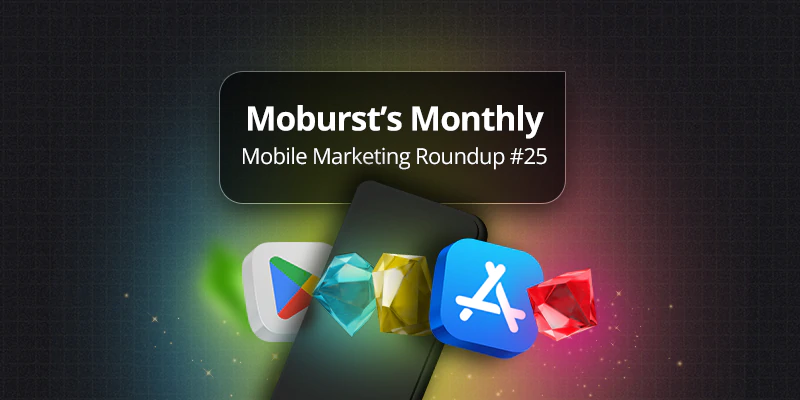Master Subscription App Growth in 2025 & Beyond

Subscription apps are facing more pressure than ever, and the landscape just changed.
A U.S. judge has ruled that Apple must allow off-platform payments without restrictions or commissions. While Apple is appealing, the implications are already material. Stripe released support for external checkout on iOS within hours of the ruling, and app developers are moving quickly to adapt.
While this shifts the economics of subscription growth, it doesn’t solve the deeper challenges.
According to RevenueCat’s 2025 industry data, the subscription space has never been more divided:
- The top 5% of new apps generate 400x more revenue than the bottom 25%
- Nearly 30% of users cancel annual subscriptions in the first month
- Over 35% of top-performing apps now rely on hybrid monetization, not subscriptions alone
Add in rising acquisition costs, shrinking attention spans, and platform policy volatility, and it’s clear that the path to growth in 2025 and beyond will be very different from what it was even six months ago.
So, how do you compete, and most importantly, win in this environment?
At Moburst, we’ve worked with some of the world’s leading subscription apps across industries. And while each challenge is unique, we consistently see the same patterns: predictable mistakes, preventable churn, and untapped growth levers.
This playbook, written by our talented VP of Strategy, Mike Kresch, distills what we’ve seen working across clients worldwide.
You’ll learn:
- Why most subscription apps stall out
- What actually works in today’s market
- How to apply these lessons before your competitors do
Why Subscription Apps Are Facing An Uphill Battle
There’s no shortage of reasons why growing a subscription app is tough. But as the data and real-world experience show, many of the challenges are predictable, preventable, and increasingly urgent.
Here are the 10 most common issues we see today:
Global Inflation is Here to Stay
According to the International Monetary Fund (IMF), global inflation is projected to decline to 4.2% in 2025 and to 3.5% in 2026, converging back to target earlier in advanced economies than in emerging market and developing economies.

While this is good news, these numbers are brutal within a historical context; over the past century, advanced economies typically see inflation fall between 2% and 4%. Consumers are still really smarting from significant post-pandemic price hikes.
Here’s how this translates: When people now see the price of a subscription app during the onboarding process, many are asking themselves a simple question, “Do I need this app right now?” and if the answer is no, they are passing – unless they decide that the inherent value of the app is too good to immediately pass on.
Is Your App’s Value Strong Enough to Drive Conversion?
If users are bouncing at the paywall, we’ll help you win them over
Shallow Market Research
One of the biggest mistakes that app start-up founders make is naively believing they are the first to bring a particular product, service, or approach to market, only to later discover that there were at least a few failed prior attempts.
The reason for this is that their preliminary research focuses too heavily on the app stores themselves, and when they don’t find anything that mirrors what they are creating, they aggressively plow ahead with product development.
Deeper research often uncovers previous attempts at doing exactly what they are setting out to do – that failed. Inadequate due diligence leads to missing critical advice and data points and can considerably reduce app performance.
The Battle for User Attention
Millions of subscription apps compete either directly or indirectly with social media for attention. Adoption of the leading social media platforms continues to increase globally, as does the time spent on these platforms. Any app that’s looking to keep consumers engaged needs to be on top of its game when it comes to every aspect of content creation.

App Stores Take Their Cut
With each subscription purchased, apps pay the App Store and Google Play Store a healthy commission for the opportunity to do business there. Back in 2021, both stores “generously” lowered the commission for apps with revenue under $1 million from 30% to 15%, but this remains a big hit to subscription apps that need every penny possible to compete in the ongoing, uber-competitive battle for user acquisition (UA).
However, a significant development occurred in May 2025: a U.S. federal judge ruled that Apple must allow developers to direct users to external payment options without imposing its customary commissions. This decision emerged from the ongoing legal battle between Apple and Epic Games, where the court found Apple in violation of a previous injunction by maintaining restrictive practices and imposing a 27% fee on external transactions.
Apple has since appealed the ruling, but the implications for subscription app developers are profound. Fret not, we will cover what this means for your growth strategy in the action plan below.
Want to Capitalize on Apple’s Payment Shift?
Our user acquisition experts can help you implement and optimize off-platform flows to retain more revenue and scale smarter
Subscription App Competition is Fierce
Business of Apps estimates that there are currently over 4 million apps across both stores. This bodes well for consumers in that in the majority of cases, depending on what they are looking for, they have several choices of apps.
In the case of choosing among subscription apps, consumers can be very discriminating; they can always opt for a lower-priced option, a longer free trial period, etc. This does not make the life of a subscription app’s product marketing manager any easier.
Inadequate Funding
It’s very common to see subscription apps that have invested heavily in creating both a beautiful UI/UX and a final deliverable that provides significant value to customers. The problem is that this requires a lot of capital, before anything is spent on any UA efforts or app store optimization (ASO) tactics.
With competitive dynamics being what they are, subscription apps need ample budgets for mobile marketing efforts. If they do not have the financial resources to compete with bigger players, they have to hope that “word of mouth” gives them the boost that they need to grow organically. This is very tough in an increasingly crowded market.
Lower-Quality Development Work
There’s also the other side of the equation: in efforts to allocate as much money as possible to customer acquisition efforts, sometimes the development side of an app doesn’t get the “love” that it needs.

This can lead to poor user experiences, and as we know, today’s consumers are not bashful about voicing their opinions. Negative ratings and reviews have a significant, negative impact on app store optimization, which in turn may have a significant impact on your app’s store performance.
Single-Revenue Models Fall Short
As with any other business category, apps with the best chance for long-term success feature business models with multiple revenue streams.
Apps that rely strictly on subscription revenue are putting all their eggs in one basket. While it’s admirable to have faith in a single offering, it’s rarely the pragmatic approach.
Ineffective (Or Non-Existent) Re-Engagement
Today’s consumer is fickle, and it’s extremely difficult to drive lower-funnel conversion within a single app download framework. How many times does a customer get halfway through an app’s onboarding process, only to be distracted by a push notification announcing a new video from Mr. Beast, Alix Earle, or Pookie & Jett? A LOT.
You see the point. Every subscription app needs a smart, data-driven re-engagement plan to bring customers back, all the way down the funnel to subscribe. Without the right re-engagement strategy, apps usually fall short of their revenue potential.
Lost Confidence, Lost Growth
When subscription app leaders don’t see immediate results, it’s all too easy to lose confidence and faith, and sometimes, potentially give up entirely, before the app is given a fair chance to make it.
The cruel reality is that building a successful subscription app takes time.
It may be several years before a high-quality subscription app breaks even. It’s completely understandable that faith is lost too early, but when that happens, leaders often start to behave cautiously and become more conservative with spending.
Very rarely does this strategy bolster chances for success.
While this list paints a somewhat ominous picture, fear not, there are plenty of practical strategies that can move the needle.
How to Grow a Subscription App in 2025
We’ve talked about why subscription apps are facing more pressure than ever. But now it’s time to shift from diagnosis to action.
Today’s global economy, rising acquisition costs, and app store volatility have created a tougher environment—but they’ve also made smart strategy more important (and more impactful) than ever.
So let’s get tactical.

First: What Not to Do
This may seem counterintuitive, but one of the most common reactions we see from app owners is to lower their subscription pricing when growth stalls. It feels logical, especially when consumer budgets are tightening. But it’s often a fatal mistake, for two reasons:
- Brand equity takes a hit: Lowering price can increase conversion in the short term, but it also lowers the perceived value of your product.
- Margins shrink fast: Lower revenue per subscriber means you need significantly more volume to hit the same targets, harder than ever in a competitive market.
If you genuinely believe pricing is the issue, test it. Use platforms like RevenueCat or Purchasely to run structured A/B tests. But don’t make the first move based on instinct alone.
Re-Evaluate the Product Itself
There are two key “yes or no” questions that need to be immediately addressed as you consider your subscription app’s positioning in the marketplace:
- Given the competitive nature of the app stores, does your subscription offer enough value?
- Is there anything unique about your offering that differentiates it from the competitive set?
If the answer to either of these questions isn’t a definitive “yes,” you have an immediate task in front of you: to address this shortcoming.
The best way to garner objective learning is through your existing customer base. Do not hesitate for a second to reach out to them directly, and by all means, ask them these additional obvious questions:
What are we doing right?
What are we doing wrong?
How can we improve?
You will often be amazed at the quality of the answers you receive—sometimes, you won’t hear what you expect! Invariably, you may need to adjust your product offering to reflect the feedback you receive. Our advice is to operate under the assumption that you will need to dedicate internal resources to address the feedback.
Revamp the Onboarding Flow
One of the attributes of successful subscription apps is that the stronger performers constantly optimize their onboarding flow. If you’re not currently doing this, now is the time to start working!
- Begin with the data that you currently see from your mobile measurement partner (MMP), and analyze the funnel of events in your flow, starting with the install, and moving down-funnel to the subscription purchase.

A quick note before we dive in: Sometimes we see that subscription apps have not implemented an MMP into their app’s SDK, instead choosing to rely exclusively on data from basic analytics.
While this might make sense from a cost perspective, it’s often the source of performance problems, as staple analytics platforms do not provide the depth and breadth of attribution data that you need to see in order to optimize funnel performance.
If this is the case, by all means, contact a leading MMP like AppsFlyer and have a preliminary conversation. We are more than happy to facilitate an introductory call if you’d like.
Losing Users During Onboarding?
We build high-performing funnels that keep users moving from install to subscription
Alright, back to the analysis of attribution data:
- Do you see a point in the sales funnel where there is a significant dropoff?
- Is there a transition from one event to another where your instinct tells you that performance should be better?
If so, the next step is to formulate a hypothesis that is built around improving performance.
Let’s look at a very common example:
Often, there is a dropoff between the point where a customer downloads a subscription app, and the funnel event where the user is asked to provide basic information (Name, address, etc).
A logical hypothesis might be that performance will improve if we lower friction by implementing social logins (Facebook, Google, Apple) as an option. As noted before, while development work needs to be done here, slight tweaks to the flow may very well push more traffic down the funnel.
Optimizing App Store Assets
The same approach can be applied to your app store assets on both the App Store and Google Play Store. Not surprisingly, top-performing subscription apps are constantly A/B testing their store assets to optimize downloads. Mobile industry SaaS solutions like AppTweak can showcase these test results.
Having implemented and measured thousands of these tests, it’s amazing to see how even the most subtle changes to a store asset can deliver amazing results!
Specifically, in working with one of the world’s leading entertainment companies, with a single, very minor tweak to the primary image on a set of iOS screenshots, we observed a 16% increase in organic downloads.

Given the size of the app, this translated into the equivalent of nearly 6-figures worth of paid media that would have had to be spent in order to achieve that level of downloads if that change wasn’t made.
It’s also important to note that changes don’t have to be visual—you can always A/B test metadata text, although app store optimization (ASO) considerations need to be taken into account here.
One easy workaround to this on iOS is testing different versions of promotional copy to see if a given topic resonates, drives more downloads. Keywords in the promo listing are not indexed for ASO purposes.
Take Advantage of New Playing Fields
Until recently, even the most sophisticated subscription growth strategies were shaped around one fixed constraint: platform fees. Developers had to navigate Apple’s 15–30% commission on every transaction made through the App Store, limiting flexibility in pricing, packaging, and promotion.
That’s now changed.
Following a federal court ruling in May 2025, Apple must allow developers to direct users to off-platform payment options without restrictions or commissions. Apple is appealing the decision, but the industry is already responding. Stripe launched native support for in-app external payments the same day, and developers are moving quickly to adapt.
This is not a reason to blow up your monetization model overnight. But it is a strategic opening to experiment in ways that weren’t feasible before.
For subscription-based apps, consider this your window to:
- Test new pricing tiers or bundle offers via external checkout links.
- Recapture margin and reinvest it into acquisition or retention efforts.
- Compare funnel performance between App Store-native and off-platform flows.
- Explore whether value-based positioning performs better when not constrained by Apple’s UI and language rules.
After facing rising acquisition costs and more selective users, this ruling doesn’t just change the economics—it changes the entire funnel.
Final Thoughts
Subscription apps are facing more pressure than ever, but also more opportunity.
The challenges are real: Inflation, higher churn, tighter budgets, and a more demanding user base. But as we’ve seen, they’re not insurmountable. With the right strategy, there’s still plenty of room to grow—and win.
To recap:
- Don’t panic-cut your pricing—test smarter first.
- Get clear on your value, and validate it with real users.
- Optimize your funnel, not just your ads.
- Tighten your app store performance.
- And yes, start planning how to take advantage of Apple’s payment changes while they’re still fresh, with the hope that they will lead to further industry shifts.
If you’re ready to make moves, Moburst is here to help. We’ve helped scale over 700 products, including some of the world’s top subscription apps. Explore our app marketing services to learn more about how we can help your brand grow.
Ready to Become a Category Leader?
Our app marketing experts are here to help






